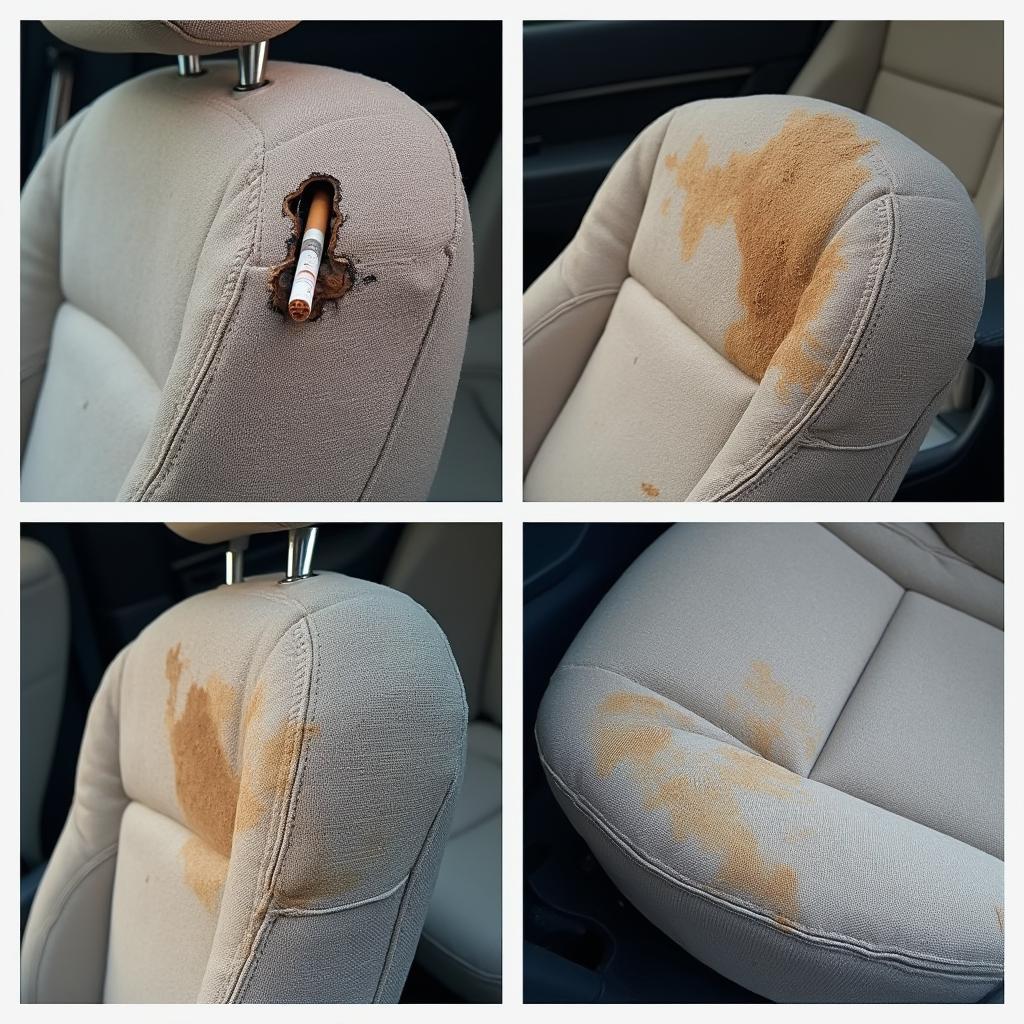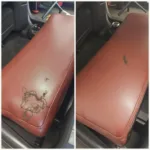Having cloth car seats can be a comfortable and stylish choice. But over time, everyday wear and tear can take a toll on their appearance and integrity. The good news is that repairing minor damage to your cloth car seats is often a manageable DIY project. This comprehensive guide will walk you through the steps on how to repair cloth car seats, restoring their look and extending their lifespan.
Assessing the Damage: Knowing What You’re Dealing With
Before diving into the repair process, it’s crucial to assess the type and extent of the damage to your car seats. This will determine the appropriate repair method and materials needed.
Common types of cloth car seat damage include:
- Fading or discoloration: Prolonged exposure to sunlight can cause the fabric to lose its vibrancy.
- Stains: Spills and dirt can leave unsightly marks on your seats.
- Tears, rips, or holes: Sharp objects or rough use can create openings in the fabric.
- Burns: Cigarette embers or hot objects can leave unsightly burn marks.
- Loose threads or seams: Friction and movement can cause threads to unravel.
Once you’ve identified the specific issues, you can gather the necessary tools and materials to tackle the repairs effectively.
Gather Your Repair Arsenal: Tools and Materials You’ll Need
Having the right tools and materials on hand will make the car seat repair process smoother and more efficient. Here’s a list of items you’ll likely need:
- Cleaning supplies: A gentle fabric cleaner, upholstery shampoo, or a mixture of mild dish soap and water.
- Microfiber cloths or sponges: For applying cleaning solutions and wiping away excess.
- A soft-bristled brush: Useful for agitating stains and cleaning seams.
- A vacuum cleaner with upholstery attachment: To remove loose dirt and debris.
- Fabric repair kit: These kits typically include fabric patches, adhesive, and a color matching guide.
- Heavy-duty fabric glue: For securing patches and repairing larger tears.
- A pair of sharp scissors: For trimming patches and loose threads.
- Tweezers: For precise handling of fabric and threads.
- Optional: Leather filler (for burn marks), sewing needle and thread (for seam repair), hairdryer (to activate certain adhesives).
Remember, the specific tools and materials required will depend on the nature and extent of the damage to your car seats.
Step-by-Step Guide: Repairing Common Cloth Car Seat Issues
Now that you have your tools and materials ready, let’s delve into the step-by-step repair process for some of the most common cloth car seat problems:
How to Repair a Cloth Car Seat Tear
- Clean the area: Using your chosen cleaning solution and a microfiber cloth, thoroughly clean the area around the tear, ensuring it’s free of dirt, dust, and debris.
- Prepare the patch (if necessary): If the tear is large, cut a patch from your fabric repair kit or a matching fabric that’s slightly larger than the tear itself. If the tear is small, you might be able to repair it without a patch.
- Apply adhesive: Carefully apply a thin layer of fabric glue to the edges of the tear and, if applicable, the underside of the patch.
- Secure the patch (if using): Align the patch over the tear and gently press it down, ensuring it adheres firmly to the seat fabric.
- Allow to dry: Let the adhesive dry completely as per the manufacturer’s instructions.
- Assess and repeat: If necessary, apply additional layers of adhesive or use a hairdryer to activate heat-set glue.
how to repair a cloth car seat tear for more detailed instructions and alternative methods for fixing tears in car seats.
How to Repair Worn Cloth Car Seats
- Clean the affected area: Gently clean the worn area with a mild fabric cleaner and a microfiber cloth, removing any surface dirt or grime.
- Choose a repair method: Depending on the severity of the wear, you can opt for fabric paint, a fabric repair kit, or upholstery fabric replacement.
- Apply fabric paint (if using): If the wear is primarily discoloration, apply fabric paint in thin, even coats, following the product instructions.
- Use a fabric repair kit (if applicable): For areas with pilling or minor fraying, a fabric repair kit can help restore the fabric’s texture.
- Consider upholstery replacement (for extensive wear): If the wear is extensive, replacing the affected upholstery panel might be the most effective solution. This often requires professional assistance.
Learn more about reviving your worn car seats in our comprehensive guide on [how to repair worn cloth car seats](https://carrepairon.com/how to-repair-worn-cloth-car-seats/).
How to Remove Stains from Cloth Car Seats
- Act quickly: The sooner you address a stain, the easier it is to remove.
- Identify the stain: Different stains require different cleaning methods. Common culprits include coffee, juice, blood, and ink.
- Blot, don’t rub: Gently blot the stain with a clean cloth to absorb as much of the spill as possible. Avoid rubbing, which can spread the stain.
- Apply cleaning solution: Use a stain remover or a mixture of mild dish soap and water. Test the solution on a hidden area of the fabric first to ensure colorfastness.
- Work from the outside in: Gently work the cleaning solution into the stain from the outer edges towards the center to prevent spreading.
- Rinse and dry: Rinse the area thoroughly with clean water and blot dry with a clean cloth.
For stubborn stains or professional-grade cleaning, consider seeking assistance from a reputable car detailing service.
Expert Insights:
“Many car owners underestimate the impact of regular cleaning on their car seats’ lifespan,” says John Miller, a veteran automotive upholstery specialist. “Vacuuming your seats regularly and addressing spills promptly can significantly reduce the likelihood of deep-set stains and premature wear.”
Preventing Future Damage: Prolonging the Life of Your Cloth Seats
Prevention is key to maintaining the pristine condition of your cloth car seats. Here are some proactive measures you can take:
- Invest in seat covers: Seat covers act as a protective barrier against spills, dirt, and UV rays.
- Regular cleaning: Vacuum your seats weekly and address spills immediately.
- Avoid eating or drinking in your car: This minimizes the risk of accidental spills.
- Park in the shade: When possible, park your car in the shade to reduce sun exposure.
By following these preventive measures and promptly addressing any minor issues, you can keep your cloth car seats looking their best for years to come.
Conclusion
Repairing cloth car seats can seem daunting, but with the right approach and a little patience, you can often restore their appearance and extend their life. Remember to assess the damage, gather the necessary tools and materials, and follow the appropriate repair steps. And if you’re unsure about a particular repair or dealing with extensive damage, don’t hesitate to seek professional assistance. With a little effort, you can keep your cloth car seats looking their best, ensuring a comfortable and enjoyable ride for miles to come.


